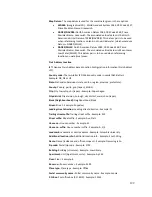
125
3-8.4 LLPD-MED
Neighbours
Parameter
Description
This page provides a status overview of all LLDP-MED neighbours. The displayed
table contains a row for each port on which an LLDP neighbour is detected. This
function applies to VoIP devices which support LLDP-MED.
Web Interface
To show LLDP-MED neighbor:
1. Click “LLDP-MED Neighbor”.
2. Click “Refresh” to manually update the web screen.
3. Click “Auto-refresh” to auto update the web screen.
Figure 3-9.4: The LLDP-MED Neighbours information
Port:
The port on which the LLDP frame was received.
Device Type:
LLDP-MED devices are comprised of two primary device types: Network
Connectivity Devices and Endpoint Devices.
LLDP-MED network connectivity device definition.
LLDP-MED network connectivity devices, as defined in TIA-1057, provide
access to the IEEE 802 based LAN infrastructure for LLDP-MED endpoint
devices. An LLDP-MED network connectivity device is a LAN access device
based on any of the following technologies:
1.
LAN Switch/Router
2.
IEEE 802.1 Bridge
3.
IEEE 802.3 Repeater (included for historical reasons)
4.
IEEE 802.11 Wireless Access Point
5.
Any device that supports the IEEE 802.1AB and MED extensions
defined by TIA-1057 and can relay IEEE 802 frames via any method.
LLDP-MED Endpoint Device Definition:
LLDP-MED endpoint devices, as defined in
TIA-1057, are located at the IEEE 802 LAN network edge and participate in IP
communication service using the LLDP-MED framework.
Within the LLDP-MED endpoint device category, the LLDP-MED scheme is broken
into further endpoint device classes, as defined in the following.
Each LLDP-MED endpoint device class is defined to build upon the capabilities
defined for the previous endpoint device class. For example, any LLDP-MED
endpoint device claiming compliance as a media endpoint (Class II) also support all
aspects of TIA-1057 applicable to generic endpoints (Class I), and any LLDP-MED
endpoint device claiming compliance as a communication device (Class III) will also
support all aspects of TIA-1057 applicable to both media endpoints (Class II) and
generic endpoints (Class I).
NOTE:
If your network without any device supports LLDP-MED, then
the table will show “No LLDP-MED Neighbour Information Found”.
















































